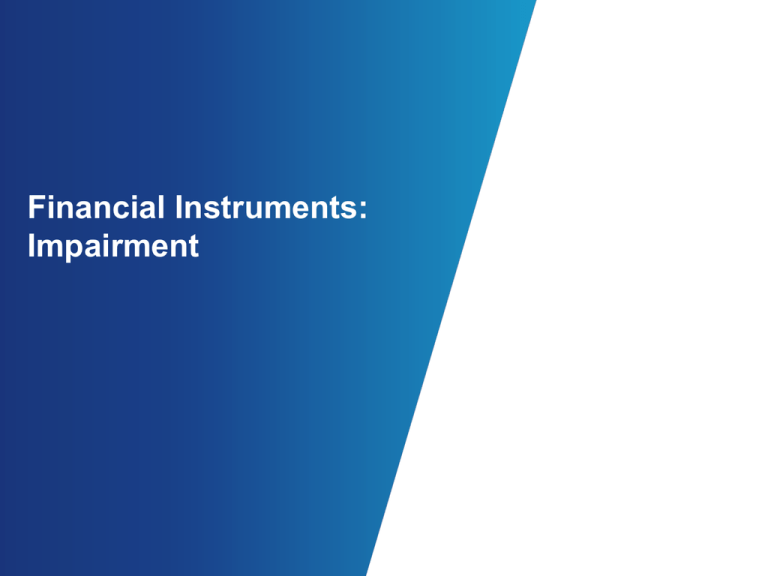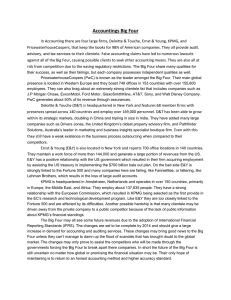
Financial Instruments:
Impairment
Scope of Expected Credit Loss (CECL) Model
Would apply to the following financial instruments
•
•
•
•
•
•
Loans, held-to-maturity debt securities and trade receivables
Receivables that result from revenue transactions
Reinsurance receivables
Lease receivables recognized by a lessor
Loan commitments
Financial guarantee contracts not accounted for as insurance or at fair value
through net income
• Loans made by a not-for-profit entity to meet its mission (programmatic loans)
Would not apply to the following
•
•
•
•
•
•
Equity instruments
Available-for-sale (AFS) debt securities
Loans made to participants by defined contribution employee benefit plans
Policy loan receivables of an insurance entity
Promises to give (pledge receivables) of a not-for-profit entity
Related party loans and receivables between entities under common control
© 2015 KPMG LLP, a Delaware limited liability partnership and the U.S. member firm of the KPMG network of independent member
firms affiliated with KPMG International Cooperative (“KPMG International”), a Swiss entity. All rights reserved. The KPMG name,
logo and “cutting through complexity” are registered trademarks or trademarks of KPMG International. Printed in the U.S.A.
2
Expected Credit Loss Model
Replaces
multiple
impairment
models for debt
instruments
measured at
amortized cost
Simplifies
accounting for
purchased
credit impaired
(PCI) financial
assets
© 2015 KPMG LLP, a Delaware limited liability partnership and the U.S. member firm of the KPMG network of independent member
firms affiliated with KPMG International Cooperative (“KPMG International”), a Swiss entity. All rights reserved. The KPMG name,
logo and “cutting through complexity” are registered trademarks or trademarks of KPMG International. Printed in the U.S.A.
Uses single
measurement
objective for
expected credit
loss
3
Recognizing Expected Credit Losses
Estimate of all contractual cash flows not expected to be collected
No recognition threshold
Allowance recognized at each reporting date
Allowance trued up by a provision in current period earnings
© 2015 KPMG LLP, a Delaware limited liability partnership and the U.S. member firm of the KPMG network of independent member
firms affiliated with KPMG International Cooperative (“KPMG International”), a Swiss entity. All rights reserved. The KPMG name,
logo and “cutting through complexity” are registered trademarks or trademarks of KPMG International. Printed in the U.S.A.
4
Measuring Expected Credit Losses
Historical
average loss
experience
Reasonable
and
supportable
forecasts
© 2015 KPMG LLP, a Delaware limited liability partnership and the U.S. member firm of the KPMG network of independent member
firms affiliated with KPMG International Cooperative (“KPMG International”), a Swiss entity. All rights reserved. The KPMG name,
logo and “cutting through complexity” are registered trademarks or trademarks of KPMG International. Printed in the U.S.A.
Estimate of
lifetime
expected
credit
losses
5
Purchased Credit-Impaired Assets
Should include individual financial assets or groups of financial assets with shared-risk
characteristics.
Acquired financial assets that have experienced a more than insignificant deterioration in
credit quality since origination, based on the assessment of the acquirer.
Interest income would be based on expected cash flows at the date of acquisition (yield held
constant).
Expected credit losses at the acquisition date would be recognized as an allowance through
a gross up to the balance sheet.
The expected credit loss allowance would not be recognized in interest income.
Subsequent increases or decreases in expected credit losses would be recognized
immediately in earnings as a provision for credit losses.
Credit impairment would follow same approach as originated assets.
© 2015 KPMG LLP, a Delaware limited liability partnership and the U.S. member firm of the KPMG network of independent member
firms affiliated with KPMG International Cooperative (“KPMG International”), a Swiss entity. All rights reserved. The KPMG name,
logo and “cutting through complexity” are registered trademarks or trademarks of KPMG International. Printed in the U.S.A.
6
Purchased Credit-Impaired Assets (continued)
Example – Purchased Credit Impaired Assets
Entity E pays $750,000 for a debt instrument with a par amount of $1,000,000. The
instrument is classified at amortized cost. At the time of purchase, the expected
credit loss embedded in the purchase price is $175,000.
The acquisition-date journal entry follows:
Loan – par amount
Loan – noncredit discount
$1,000,000
$ 75,000
Allowance for credit losses
175,000
Cash
750,000
© 2015 KPMG LLP, a Delaware limited liability partnership and the U.S. member firm of the KPMG network of independent member
firms affiliated with KPMG International Cooperative (“KPMG International”), a Swiss entity. All rights reserved. The KPMG name,
logo and “cutting through complexity” are registered trademarks or trademarks of KPMG International. Printed in the U.S.A.
7
Modified Debt Instruments
New loan - non-troubled debt restructuring (TDR)
modifications
• Expected credit losses would be based on the contractual cash flows
post modification – discounted using the post-modification EIR
TDR modifications
• EIR used for measuring expected credit losses would be the original
(pre-modification) EIR
• Cost basis would be adjusted so the EIR post-modification would be
the same as the original EIR, given the new series of cash flows
• Cost basis would be increased or decreased
• The cost basis adjustment = amortized cost basis prior to the TDR
less PV of the modified contractual cash flows (discounted at the
original EIR)
© 2015 KPMG LLP, a Delaware limited liability partnership and the U.S. member firm of the KPMG network of independent member
firms affiliated with KPMG International Cooperative (“KPMG International”), a Swiss entity. All rights reserved. The KPMG name,
logo and “cutting through complexity” are registered trademarks or trademarks of KPMG International. Printed in the U.S.A.
8
Available-For-Sale Credit Loss Model
Impairment recognized using an allowance approach
Reversals of credit losses may occur
Length of time the fair value has been less than
amortized cost is not considered
© 2015 KPMG LLP, a Delaware limited liability partnership and the U.S. member firm of the KPMG network of independent member
firms affiliated with KPMG International Cooperative (“KPMG International”), a Swiss entity. All rights reserved. The KPMG name,
logo and “cutting through complexity” are registered trademarks or trademarks of KPMG International. Printed in the U.S.A.
9
Disclosures
Qualitative disclosures
about how an entity
estimates expected losses,
including changes in
techniques and credit loss
expectations
Rollforward of the allowance
for expected credit losses
for financial assets
measured at amortized cost
and FV-OCI
A discussion of the type of
collateral and extent to
which collateral secures an
entity’s financial assets
Current credit quality
indicators that are disclosed
under current GAAP would
be disaggregated by year of
origination
Reconciliation between the
purchase price and the par
value of PCI financial assets
at the time of purchase
AFS debt securities
• Retain current disclosure requirements, updated for the general principles regarding
disclosing credit risk
© 2015 KPMG LLP, a Delaware limited liability partnership and the U.S. member firm of the KPMG network of independent member
firms affiliated with KPMG International Cooperative (“KPMG International”), a Swiss entity. All rights reserved. The KPMG name,
logo and “cutting through complexity” are registered trademarks or trademarks of KPMG International. Printed in the U.S.A.
10
Transition
Other-than-temporarily impaired debt securities
• Prospectively
• Amounts in AOCI as of the date of adoption that relate to significant
improvements in cash flow will continue to be accreted to interest
income on a level-yield basis
PCI financial assets
• All loans and debt securities acquired with deteriorated credit quality
for which an entity applies Subtopic 310-30 (including by analogy) will
be classified as PCI at the date of adoption
• At the date of adoption, gross up the allowance for lifetime expected
credit losses with a corresponding adjustment to the carrying value
• Interest income will be recognized based on the yield as of the date of
adoption
All other assets
• Cumulative-effect adjustment to the statement of financial position as
of the beginning of the first reporting period
© 2015 KPMG LLP, a Delaware limited liability partnership and the U.S. member firm of the KPMG network of independent member
firms affiliated with KPMG International Cooperative (“KPMG International”), a Swiss entity. All rights reserved. The KPMG name,
logo and “cutting through complexity” are registered trademarks or trademarks of KPMG International. Printed in the U.S.A.
11
Effective Date and Transition Disclosures
Effective Date
• To be decided after considering constituent feedback (most likely
calendar 2018 or 2019)
Transition disclosures would apply, including:
• Nature and reason for the change in accounting principle
• Method of applying adoption
• Effect of the adoption on line items on the statement of financial
position, if material, as of the beginning of the first period for which
the guidance is effective
• Cumulative effect of the change on retained earnings or other
components of equity
© 2015 KPMG LLP, a Delaware limited liability partnership and the U.S. member firm of the KPMG network of independent member
firms affiliated with KPMG International Cooperative (“KPMG International”), a Swiss entity. All rights reserved. The KPMG name,
logo and “cutting through complexity” are registered trademarks or trademarks of KPMG International. Printed in the U.S.A.
12
Impairment - Significant Differences Between FASB and
IASB models
Subject
FASB ED and Tentative
Decisions
IFRS 9
Measurement Objective
Single measurement objective for
measuring expected credit losses
Dual-measurement objective
Instruments Measured at
FV-OCI
Targeted amendments to current
OTTI model
No limit is provided
Measurement
Current estimate of contractual
cash flows not expected to be
collected
For assets in Stage 1,
impairment would be measured
as all shortfalls in cash flows
over the life of the financial
assets that are associated with
the probability of a loss in the
12 months after the reporting
date
For assets in Stage 2 or 3,
lifetime expected credit losses
would be recognized
© 2015 KPMG LLP, a Delaware limited liability partnership and the U.S. member firm of the KPMG network of independent member
firms affiliated with KPMG International Cooperative (“KPMG International”), a Swiss entity. All rights reserved. The KPMG name,
logo and “cutting through complexity” are registered trademarks or trademarks of KPMG International. Printed in the U.S.A.
13
Impairment - Significant Differences Between FASB and
IASB models (continued)
Subject
FASB ED and Tentative
Decisions
IFRS 9
PCI Financial
Assets
The purchase discount associated
with expected credit losses would be
recognized as an allowance at the
acquisition date. Impairment would
always reflect the entity’s current
estimate of contractual cash flows
that it does not expect to collect
Expected credit losses at the
acquisition date would be factored
into the effective interest rate (and
would not be recognized as an
allowance). Therefore, impairment
would be based on the change from
initial expected credit losses
Interest Income
Recognition
Does not include a similar provision
Would require interest income to be
calculated on net carrying amount for
financial assets that are ‘impaired’
(i.e. Stage 3)
© 2015 KPMG LLP, a Delaware limited liability partnership and the U.S. member firm of the KPMG network of independent member
firms affiliated with KPMG International Cooperative (“KPMG International”), a Swiss entity. All rights reserved. The KPMG name,
logo and “cutting through complexity” are registered trademarks or trademarks of KPMG International. Printed in the U.S.A.
14
Financial Instruments:
Classification and
Measurement
Classification and Measurement - Accounting
Equity investments
Financial liabilities measured at fair value
Assessment of a valuation allowance for a DTA related
to an available-for-sale security
© 2015 KPMG LLP, a Delaware limited liability partnership and the U.S. member firm of the KPMG network of independent member
firms affiliated with KPMG International Cooperative (“KPMG International”), a Swiss entity. All rights reserved. The KPMG name,
logo and “cutting through complexity” are registered trademarks or trademarks of KPMG International. Printed in the U.S.A.
16
Classification and Measurement – Presentation and
Disclosure
Public business entities:
present the fair value of
financial assets and
financial liabilities that
are measured at
amortized cost either
parenthetically on the
balance sheet or in the
notes
Disclose all financial
assets and financial
liabilities grouped by
both measurement
category and form of
financial assets
For equity investments without a
readily determinable fair value
disclose: carrying amount, amount of
impairments, and the observable and
unobservable adjustments, if any, for
the annual period
For financial instruments
measured at amortized
cost, disclosures about
fair value will be limited to:
Fair value amounts,
disaggregated by major
asset category and fair
value hierarchy Level 1, 2,
or 3
For bifurcated embedded derivatives:
- Carrying amount;
- Measurement attribute; and
- B/S line item in which the bifurcated
embedded derivatives and related host
contracts are presented
© 2015 KPMG LLP, a Delaware limited liability partnership and the U.S. member firm of the KPMG network of independent member
firms affiliated with KPMG International Cooperative (“KPMG International”), a Swiss entity. All rights reserved. The KPMG name,
logo and “cutting through complexity” are registered trademarks or trademarks of KPMG International. Printed in the U.S.A.
17
Classification and Measurement
Final standard expected second half 2015
To be decided after considering constituent feedback
(most likely calendar 2018 or 2019)
Transition:
• Modified retrospective application
• Prospective for certain equity securities
© 2015 KPMG LLP, a Delaware limited liability partnership and the U.S. member firm of the KPMG network of independent member
firms affiliated with KPMG International Cooperative (“KPMG International”), a Swiss entity. All rights reserved. The KPMG name,
logo and “cutting through complexity” are registered trademarks or trademarks of KPMG International. Printed in the U.S.A.
18
Classification and Measurement - Significant Differences
Between FASB and IASB models
Subject
Basis for Classification
and Measurement
FASB
IFRS 9
Intent and ability on an asset- Based on cash flow
by-asset basis
characteristics and business
model
Categories
• Trading
• Available for Sale
• Held to Maturity (tainting
notion)
• Loans Held for Sale (Lower
of Cost or FV)
• Loans Held for Investment
• FV - P&L
• FV - OCI
• Amortized cost (no tainting)
FVO
Unconditional
Conditional:
• Financial asset and/or
financial liabilities
• Accounting mismatch
• Certain hybrid instruments
Embedded Derivatives
Bifurcation guidance applies
for financial assets and
financial liabilities
Bifurcation guidance does
not apply for financial assets,
but does for financial
liabilities
© 2015 KPMG LLP, a Delaware limited liability partnership and the U.S. member firm of the KPMG network of independent member
firms affiliated with KPMG International Cooperative (“KPMG International”), a Swiss entity. All rights reserved. The KPMG name,
logo and “cutting through complexity” are registered trademarks or trademarks of KPMG International. Printed in the U.S.A.
19
Financial Instruments:
Hedging
Financial Instruments Project – Hedging
Targeted improvements
Scope of project may include:
• Hedge effectiveness threshold.
• Hedging components of non-financial items.
• Elimination of shortcut and critical terms match methods.
Board expected to begin deliberations
© 2015 KPMG LLP, a Delaware limited liability partnership and the U.S. member firm of the KPMG network of independent member
firms affiliated with KPMG International Cooperative (“KPMG International”), a Swiss entity. All rights reserved. The KPMG name,
logo and “cutting through complexity” are registered trademarks or trademarks of KPMG International. Printed in the U.S.A.
21







